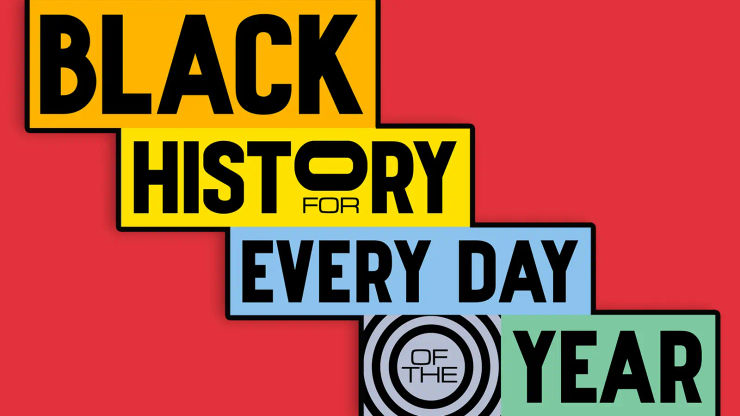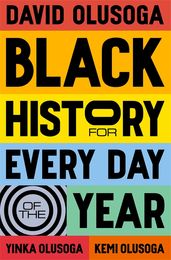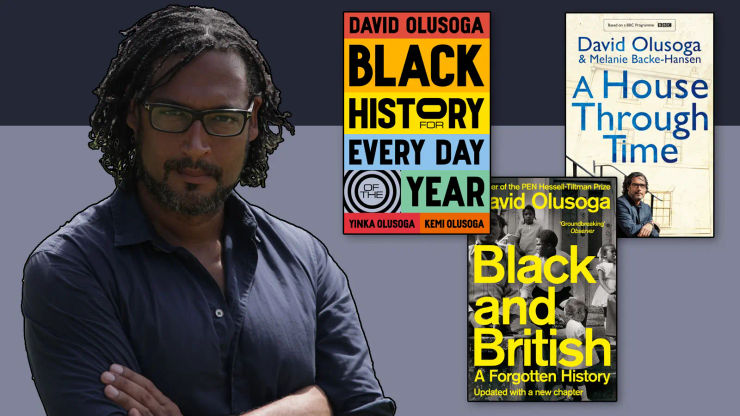Black history for every day of the year: well known figures and unsung heroes
The new book by historian and broadcaster David Olusoga and his siblings, Yinka and Kemi Olusoga, will change everything you thought you knew about history and the people who have shaped it.

Each of the 366 daily entries in Black History for Every Day of the Year, by historian and broadcaster David Olusoga and his siblings, Yinka and Kemi, is a portal into the life of a person, group of people, place or event that is part of Black history and part of global history. Some you might already have heard of, and can now learn more about, but others will possibly be new to you.
In these extracts from the book, we hear about Africa’s first elected female head of state, a turning point in the history of the struggle against racial injustice in the UK, the African American inventor of the traffic light, a polar explorer from Maryland, the Black singer whose Second World War radio performances entertained the troops, and the nineteenth-century conference where fourteen European nations discussed how they could colonize Africa.
16 January: Ellen Johnson Sirleaf
On 16 January 2006 Ellen Johnson Sirleaf was inaugurated as president of Liberia, becoming Africa’s first elected female head of state.
Johnson Sirleaf was born in Liberia’s capital city, Monrovia, in 1938. In the 1960s she attended university in the US, eventually gaining a master’s degree from Harvard. She returned to Liberia in the early 1970s where she became first the assistant minister of finance in the treasury department, and later the minister of finance, before the government was overthrown in a coup d’état in 1980. Johnson Sirleaf spent many years living in exile, working in banking and then for the United Nations Development Programme. She returned to Liberia to run for president in 1997 and was finally elected in 2005.
Johnson Sirleaf served two full terms as president, before she retired and oversaw the first peaceful, democratic transition of power in Liberia in seventy-three years. In 2011 she was awarded the Nobel Peace Prize for her role in securing the end of the fourteen-year-long civil war in Liberia.
2 March: Black People’s Day of Action
After thirteen young Black people died in the New Cross Fire* it seemed to many local Black people that the police and the media were not taking the matter seriously. The community realized that they were going to have to come together to protest. A week after the fire, on 25 January 1981 at a public meeting, the New Cross Massacre Action Committee was formed. The activist and publisher John La Rose was elected as its chairman. The group made the decision to ask Black community groups and leaders to come together on 2 March 1981 for the Black People’s Day of Action. They chose a working day instead of the weekend to show just how serious they thought the injustice to the victims of the fire was.
‘The few stories about the march in the newspapers the next day blamed the protestors for the scuffles on Fleet Street instead of focusing on the reasons for the march. Despite this, the sheer scale of the protest made it a turning point in the history of the struggle against racial injustice in the United Kingdom.’
2 March was a rainy day, and the 20,000 people who answered the call marched for eight hours through the wet London streets chanting ‘Thirteen dead, nothing said’. The route was planned carefully, taking the protestors from the scene of the fire across London and ending at the Houses of Parliament. As they passed through Fleet Street, where the newspapers who had done little to report the fire had their offices, there were some scuffles when people shouted racist abuse at the marchers. They also passed the Royal Courts of Justice to make the point that no progress had been made by the police to bring those responsible for the fire to justice. Once they reached the Houses of Parliament they handed over a petition to the government and the commissioner of the Metropolitan Police that stated their concerns. The few stories about the march in the newspapers the next day blamed the protestors for the scuffles on Fleet Street instead of focusing on the reasons for the march. Despite this, the sheer scale of the protest made it a turning point in the history of the struggle against racial injustice in the United Kingdom.
24 July: Garrett Morgan
African American inventor Garrett Morgan was born in Kentucky on 4 March 1877. His mother was of Native American and African descent, and his father had formally been enslaved. Morgan did not finish high school and by the age of fourteen he had left home, moving away to find work, first in Cincinnati and then in Cleveland where he lived for the rest of his life. It was when he started working in sewing machine factories that Morgan began inventing things and applying for patents for a wide range of ideas. He invented ways to improve how sewing machines work, and once accidentally invented a bestselling hair-straightening treatment, when he was attempting to invent a way of making material run more smoothly through machines when it was being sewn.
‘He took his breathing devices to trade shows across America, but found that many fire departments were not prepared to buy equipment from a Black inventor. So Morgan employed a white actor to pretend to be the inventor at these events while he wore the apparatus to demonstrate how it worked.’
On 25 March 1911, Morgan learned about a fire in a clothing factory that killed 146 female workers. He realized that if the firefighters had had proper breathing devices the death toll might have been less. He drew up successful designs and his device even became adapted during the First World War to protect soldiers from toxic gas attacks. He took his breathing devices to trade shows across America, but found that many fire departments were not prepared to buy equipment from a Black inventor. So Morgan employed a white actor to pretend to be the inventor at these events while he wore the apparatus to demonstrate how it worked. Morgan also used his breathing device on 24 July 1916 when there was an explosion in a tunnel under Lake Erie. He and his brother rescued eight trapped men, but were not given public recognition at the time.
In 1923, having witnessed a bad crash between a car and a horse-drawn carriage at the intersection between two roads, Morgan invented a three-way traffic signal. Instead of just having ‘stop’ and ‘go’ it also had a ‘warning’ position to let drivers know that the signal was about to turn to ‘stop’. He patented his idea in America, Canada and Britain and was able to sell the rights for $40,000, which is just under $7 million dollars today.
‘Morgan used his wealth to support other African Americans and established a weekly African American newspaper called the Cleveland Call.’
Morgan used his wealth to support other African Americans and established a weekly African American newspaper called the Cleveland Call. He was an early member of the NAACP. He bought 250 acres of land and opened a country club for African Americans and he gave money to many colleges and universities that offered higher education for African Americans.
Morgan did eventually receive public recognition for his role in the Cleveland Tunnel rescue. He also won prizes for his invention of breathing devices. Morgan died in 1963, aged eighty-seven, survived by his second wife and three children. Just after he died he was honoured for his traffic light invention at a national event to celebrate a century since the Emancipation Declaration that announced the end of slavery.
8 August: Matthew Henson
The African American explorer Matthew Henson was born on 8 August 1866 in Nanjemoy, Maryland. He was twelve when he began his life of travel, working as a cabin boy on a merchant ship. At the age of twenty-one, Henson met Commander Robert E. Peary, and joined his team for an expedition to Nicaragua. Henson and Peary went on to undertake seven expeditions to the Arctic over the next twenty years.
‘Peary claimed that he, Henson and their four Inuit guides, Ootah, Seeglo, Egingwah, and Ooqueah, reached the North Pole. This claim was disputed, and it is possible that, due to navigation errors, they were some miles short of the pole. However, the National Geographical Society and the US House of Representatives both accepted the claim.’
During their expedition to Greenland in 1908–09, Peary claimed that he, Henson and their four Inuit guides, Ootah, Seeglo, Egingwah, and Ooqueah, reached the North Pole. This claim was disputed, and it is possible that, due to navigation errors, they were some miles short of the pole. However, the National Geographical Society and the US House of Representatives both accepted the claim. Henson published a memoir, A Negro Explorer at the North Pole, in 1912. He wrote that he had been the first to reach the pole, had overshot it and had to retrace his steps in the snow before planting the American flag.
In 1937 Henson became the first African American to be given life membership of the Explorers Club, and in 1944 the US Congress awarded the six men the Peary Polar Expedition Medal.
Henson died in 1955 and in 1988 his remains, along with those of his wife, were moved to rest at Arlington National Cemetery. In 2000, the Geographical Society posthumously awarded Henson the Hubbard Medal for distinction in exploration, discovery and research.
7 October: Evelyn Dove
Evelyn Mary Dove was born in London on 11 January 1902 to an English mother and Sierra Leonean father. Her father was a barrister, and Evelyn had a comfortable childhood and a good education. She attended the prestigious Royal Academy of Music, where she studied piano, singing and elocution. She began her career working in all-Black orchestras and revue shows, touring Britain, Europe, India and America.
‘Evelyn Dove became the first ever Black singer to feature on BBC Radio. . . During the Second World War, her radio performances would entertain the troops, and she became even more popular and well known.’
By the late 1930s Dove was also appearing on the radio, and she became the first ever Black singer to feature on BBC Radio. She starred with singer Edric Connor in over fifty episodes of the musical variety radio show Serenade in Sepia. During the Second World War her radio performances would entertain the troops, and she became even more popular and well known.
After the war Dove became one of the first Black people to appear on British television when she performed in a television special featuring Black entertainers. The show, Variety in Sepia, was broadcast on 7 October 1947, live from the RadiOlympia Theatre at Alexandra Palace in London.
15 November: The Berlin Conference
On Saturday 15 November 1884, the Berlin Conference began. It was an international conference that lasted three months, during which representatives from fourteen European nations met to discuss how they could colonize the continent of Africa. Two representatives of the United States of America also attended to monitor the talks and report back to the American government, but no representatives from any African state were invited.
‘At the Berlin Conference the powerful nations of Europe met to agree which parts of Africa they were each to attempt to conquer.’
For centuries, European nations had made money from the enslavement of African people, taking them from Africa to grow cash crops like sugar and cotton in colonies in the Americas and West Indies. Europeans had carried out this trade with African rulers and had built a network of forts on the coast of Africa, but they had not been able to take control of land in the centre of the African continent. By the 1880s new weapons and better medicines meant that for the first time European armies were able to invade African kingdoms inland, far away from the coast.
At the Berlin Conference the powerful nations of Europe met to agree which parts of Africa they were each to attempt to conquer. The conference was an important moment in what became known as the ‘Scramble for Africa’. Before the scramble, in 1870, 90% of African land was controlled by Africans. By the end of the scramble in 1900 that figure was only 10%. Just two African nations, Liberia and Ethiopia, remained independent. Millions of people and 9 million square miles of African territory had been brought under European control, meaning that European empires controlled one-fifth of the land area of the world.
Black History for Every Day of the Year
by David Olusoga
Spanning continents and centuries, and celebrating unsung heroes and familiar names, Black History for Every Day of the Year is the new book from David Olusoga and his siblings, Yinka Olusoga and Kemi Olusoga. Each day of the year covers a different event in Black history, from the anti-slavery movement of the nineteenth century to the World Wars, the Harlem Renaissance and beyond. Richly presented with quotes, illustrations, pictures, and poems, this beautiful book will inspire and educate history lovers of all ages.
*In the early hours of 18 January 1981, thirteen young Black people were killed when a fire swept through a house in the New Cross area of London. They had been attending a birthday party. The eldest victim was twenty-two and the youngest was just fourteen. One survivor died by suicide two years later.



